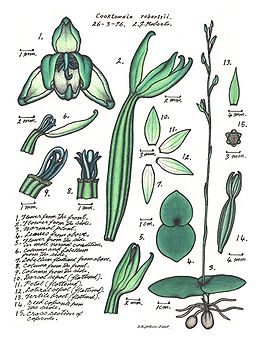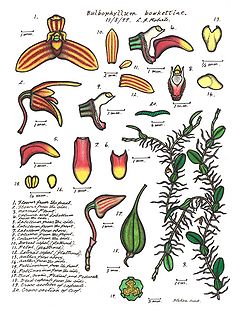
Lewis Roberts (naturalist)
Encyclopedia


Order of Australia
The Order of Australia is an order of chivalry established on 14 February 1975 by Elizabeth II, Queen of Australia, "for the purpose of according recognition to Australian citizens and other persons for achievement or for meritorious service"...
, (born 1950) is a distinguished naturalist
Naturalist
Naturalist may refer to:* Practitioner of natural history* Conservationist* Advocate of naturalism * Naturalist , autobiography-See also:* The American Naturalist, periodical* Naturalism...
and botanical illustrator
Botanical illustrator
A botanical illustrator is a person who paints, sketches or otherwise illustrates botanical subjects such as trees and flowers. The job requires great artistic skill, attention to fine detail, and technical botanical knowledge...
. Lewis and his brother, Charlie Roberts, are probably the leading experts on the flora and fauna of south-eastern part Cape York Peninsula
Cape York Peninsula
Cape York Peninsula is a large remote peninsula located in Far North Queensland at the tip of the state of Queensland, Australia, the largest unspoilt wilderness in northern Australia and one of the last remaining wilderness areas on Earth...
and the northern Wet Tropics area. For three generations his family has lived at Shipton's Flat, about 45 km south of Cooktown, where he and Charlie were home-schooled. His father, Jack Lewis, was a tin
Tin
Tin is a chemical element with the symbol Sn and atomic number 50. It is a main group metal in group 14 of the periodic table. Tin shows chemical similarity to both neighboring group 14 elements, germanium and lead and has two possible oxidation states, +2 and the slightly more stable +4...
miner
Miner
A miner is a person whose work or business is to extract ore or minerals from the earth. Mining is one of the most dangerous trades in the world. In some countries miners lack social guarantees and in case of injury may be left to cope without assistance....
and self-taught naturalist.
Background
Since about 1960, most of the botanists and zoologists who have conducted research in their area have sought advice or field assistance from the Roberts brothers. Both are "Honoraries" to the Queensland MuseumQueensland Museum
The Queensland Museum is the state museum of Queensland. The museum currently operates four separate campuses; at South Brisbane, Ipswich, Toowoomba and Townsville.The museum is funded by the State Government of Queensland.-History:...
.
Lewis Roberts has a particular interest in orchids, especially the species of Cape York Peninsula and the Wet Tropics. He commenced serious study in 1973.
Since then, he has collected many specimens, and discovered seven new species, including an unusual orchid, known only at Shipton’s Flat, for the National Herbarium
Herbarium
In botany, a herbarium – sometimes known by the Anglicized term herbar – is a collection of preserved plant specimens. These specimens may be whole plants or plant parts: these will usually be in a dried form, mounted on a sheet, but depending upon the material may also be kept in...
in Canberra
Canberra
Canberra is the capital city of Australia. With a population of over 345,000, it is Australia's largest inland city and the eighth-largest city overall. The city is located at the northern end of the Australian Capital Territory , south-west of Sydney, and north-east of Melbourne...
. This ground orchid, which has been listed in a new genus of its own, was named Cooktownia robertsii, in Lewis' honour. Lewis discovered this rare ground orchid in the 1980s and it was formally described by David L. Jones, one of Australia’s leading orchid taxonomists, in 1997.
Many of the local orchid species are rare and have very specific and limited ranges, occurring only in remote, inaccessible places such as particular mountain peaks, swamps or types of rain forest accessible only on foot. Additionally, most orchids flower seasonally, and some for only one or two days a year!
In 1993, Lewis began to draw the orchids he found. He is a self-taught botanical illustrator. His early works were in pencil done purely as an aid to identification. He was fastidious about showing the most minute details. He showed some of his penciled works to visiting fellow naturalists, and prompted by them, Lewis began colouring and highlighting his illustrations. He has devised his own techniques to capture the scale and complexity of his subjects, many of which are barely visible to the naked eye.
Lewis works in pencil to outline his subject using a magnifying glass, when necessary. He captures the colour of the subject in watercolour, then highlights and shades with pen and ink.
Lewis hopes to illustrate a specimen of every orchid species found in north-eastern Queensland. There are over 250 species known in the region and he has completed illustrations of well over 100. Once he has finished the series, Lewis hopes to publish them, along with his field observations on each species, but it will take many more years to illustrate them all.
Following the conventions of botanical illustration
Botanical illustration
Botanical illustration is the art of depicting the form, colour, and details of plant species, frequently in watercolour paintings. These are often printed with a botanical description in book, magazines, and other media...
, Lewis records his subjects comprehensively – plant, flower and fruit. He also dissects the flowers of each to show its various parts – petals, sepal
Sepal
A sepal is a part of the flower of angiosperms . Collectively the sepals form the calyx, which is the outermost whorl of parts that form a flower. Usually green, sepals have the typical function of protecting the petals when the flower is in bud...
, column
Column
A column or pillar in architecture and structural engineering is a vertical structural element that transmits, through compression, the weight of the structure above to other structural elements below. For the purpose of wind or earthquake engineering, columns may be designed to resist lateral forces...
, labellum
Labellum
Labellum is the Latin diminutive of labium, meaning lip. These are anatomical terms used descriptively in biology, for example in Entomology and botany.-Botany:...
, anther and pollinia.
The process is exacting and time consuming. Not allowing for time taken to find suitable specimens of particular species – some take years – each illustration takes between 2 and 3 days to complete, depending on the complexity and size of the plant.
Lewis leads many groups of naturalists and hikers and is renowned for his knowledge and bush skills. He always goes bushwalking (hiking) barefoot, and has only worn shoes a few times in his life mainly on special occasions, such as when he was married, at the opening of his first exhibition at Nature's Powerhouse, and when presented with the Medal of the Order of Australia (OAM) in 2005.
Exhibitions
Over 80 prints of his orchid illustrations are held at Nature's PowerHouse Environment and Interpretive Centre in the Cooktown Botanic Gardens, where some are on display. The collection was exhibited at the opening of the MackayMackay, Queensland
Mackay is a city on the eastern coast of Queensland, Australia, about north of Brisbane, on the Pioneer River. Mackay is nicknamed the sugar capital of Australia because its region produces more than a third of Australia's cane sugar....
Botanic Gardens and travels to other galleries.
There was a major exhibition of prints of Lewis' work was held in Nature's PowerHouse from 24th October, 2004, which lasted for a month.
Another exhibition of his prints was displayed at the Foyer Gallery in Atherton, Queensland
Atherton, Queensland
Atherton is a town on the Atherton Tablelands of Far North Queensland, Australia. At the 2006 census, Atherton had a population of 7,068.-Roads:...
from the 3rd to the 28th, May 2010.
External links
- Biography of Lewis Roberts
- An on-line gallery featuring 81 of Lewis Roberts' orchid illustrations
- Classification of Cooktownia robertsii.

